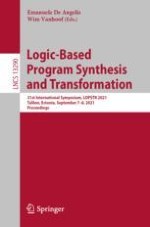2022 | Buch
Logic-Based Program Synthesis and Transformation
31st International Symposium, LOPSTR 2021, Tallinn, Estonia, September 7–8, 2021, Proceedings
herausgegeben von: Emanuele De Angelis, Prof. Wim Vanhoof
Verlag: Springer International Publishing
Buchreihe : Lecture Notes in Computer Science
